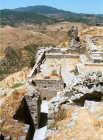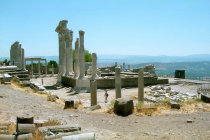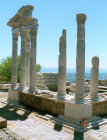another view of the Theatre, one of the steepest in the world
and there are plenty more steep places to the left of us
a view of Bergama from the upper Acropolis
the ceremonial ablation fountain is situated within the mosque
time to rest against a milennia old pilar
but repairs are under way
the Hellenistic theater provides ample seats for us
Bursa was the first capital of the Ottoman State and a place of spiritual importance. Hence the city sports many mosques, of
which the
Ulu Cami Grand Mosque is the largest. Built in 1399 by
Sultan Bayesid I, this mosque is a fine example
of early Ottoman architecture. The ablution
fountain to wash-up is located inside the mosque.
Close to present day Bergama loom
the ruins of Pergamon, once an important and wealthy Hellenistic city.
Under Roman
rule Pergamon became an important spa and healing center.
An earthquake in 262 AD and a
sacking by the Goths drove the city into decline.
Persians Arabs and Byzantines further left their destructive marks and
what remained was taken over by the Ottomans.
We visited Bursa and the Pergamon ruins in August 1996.








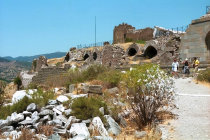
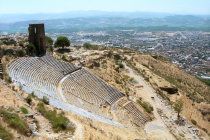

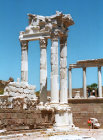





waiting at the Bursa Mosque











































he lost his head a long long time ago



this is all that remains from the temple of Trajan
